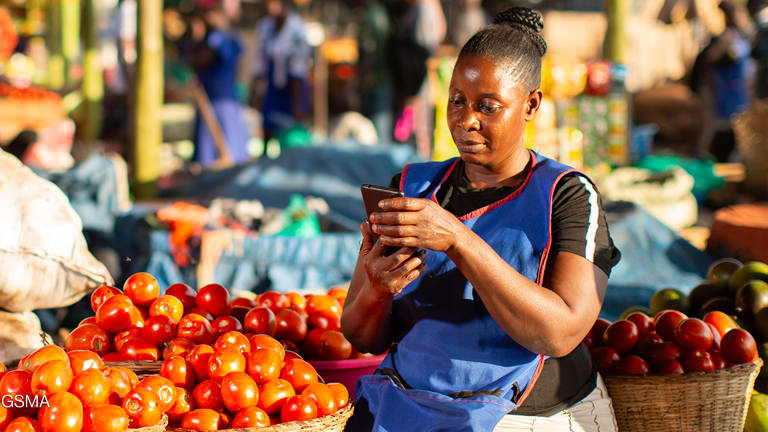
BARCELONA — In many developing countries, the practice of sharing one mobile phone among family members impacts a woman's ability to freely use the device.
Husbands, fathers or brothers may track or question how women use the phone. In some cases, women have use of the phone only when men go to work — when they are already busy caring for the home and the children, Sarbani Banerjee Belur, a researcher focused on the barriers to mobile phone usage for women in rural India, told Devex via email.
Even women who do have phones of their own are often not able to use them whenever they please, whether due to close monitoring of their activity by men in the household, or because they receive random missed calls, unknown friend requests, or messages from strangers — all things that lead them to leave their phones off, Belur said.
Women are 10 percent less likely than men to own a mobile phone, and 313 million fewer women than men use mobile phones, according to a 2019 report released at Mobile World Congress this week by GSMA, the trade body representing the interests of mobile network operators. The research, supported by the donor agencies of Sweden and the United Kingdom, examines the mobile gender gap and states that women are 23 percent less likely than men to use mobile internet.
The mobile gender gap, like the digital divide more broadly, could lead to mobile phones being tools for exclusion rather than tools for inclusion and development. According to GSMA, closing the gender gap over the next five years is a $140 billion commercial opportunity and a $700 billion economic opportunity.
These numbers interest mobile network operators, as does the moral imperative to close the gender gap, experts tell Devex. And the mobile industry will look to the global development community to help make it happen.
Committing to progress
At the 2016 Mobile World Congress, mobile operators made commitments to close the gender gap, setting targets for 2020. So far, 37 operators from 27 countries reached 16 million women. Every 6 months, these operators report back to GSMA.
“The mobile industry is on board, but these operators can’t do it alone,” said Claire Sibthorpe, head of Connected Women and Connected Society at GSMA.
When it comes to affordability, governments could support the industry to develop pro-poor infrastructure and lower the upfront cost of mobile handsets. NGOs can add value by providing digital literacy training for women, developing services to help women feel safer online, and producing content that is relevant to women and available in their local language
The private sector, governments, and the global development community could work together to improve the quality of gender-disaggregated data so they can set gender equity targets and track their progress against them.
It’s important that each of these actors better understands the stories behind the data by asking what needs women have, and involving them in the design and implementation of products, services, and policies that work for them by testing with female end users, said Oliver Rowntree, senior insights manager of Connected Women at GSMA.
The role of mobile network operators
Even as awareness of mobile internet grows, women need to understand how and why they should use these services, according to leaders from mobile network operators gathered at MWC in Barcelona, Spain, this week.
For example, Selorm Adadevoh, CEO at MTN Ghana, talked about his company’s work with GSMA’s Connected Women initiative to increase the number of female agents in their MoMo pay service, which allows merchants to receive payments using MTN Mobile Money.
“Women feel more comfortable transacting with women,” he said.
The company is sharing data on these efforts in April, but Adadevoh gave a preview of the results: “Trust is higher,” he said. While the primary rationale for this program was more social than commercial, the effort has also been good for business, Adadevoh explained.
Phumzile Mlambo-Ngcuka, executive director at UN Women, presented a call to action for any companies that might address the issue of not just accessibility to mobile broadband, but affordability of devices: “Give it away guys,” she said. “Make the devices affordable or cost neutral — because the benefits for everybody in the long-term are huge.”
She spoke in an onstage interview with Mats Granryd, director general at GSMA, who took some of the pressure off mobile network operators when he asked what role governments might play in subsidizing headsets.
The urgency for action
While the mobile industry is doing more to embrace its role in advancing the global development agenda — due in part to the way GSMA has highlighted the Sustainable Development Goals at MWC — global development leaders must keep in mind that these are businesses that answer to shareholders.
“We need to think about financing mechanisms,” Sibthorpe told Devex. “It doesn’t need to be profitable, but we need to ask: ‘Who pays?’”
Much of the conversation at MWC this week centered on 5G, the latest generation of mobile internet. But for many developing countries, higher speed data services including 3G and 4G seem “a long way off,” according to research by mobile top-up platform Ding. As more of the world upgrades to 5G, there is an even more urgent need for developing countries to upgrade their 2G networks to 3G and 4G so they do not fall further behind.
“The cost of not upgrading to 3G is your rate of development will suffer,” said Atul Mehta, a senior director at the International Finance Corporation, at an event in San Francisco, California, in 2018, where the private sector arm of the World Bank Group launched a new initiative called Digital2Equal. “The implications of this not happening are not just a missed phone call anymore.”
If women do not have high-speed service or a smartphone device, they cannot benefit from the opportunities that a platform economy can offer to entrepreneurs, he said.
A new partnership model promises mobile broadband for rural populations
A technology giant, two development banks, and a telecommunications company are collaborating to make bridging the digital divide a viable business venture in Peru.
With IFC, Mehta makes and manages investments in the telecom industry. He pointed to shared infrastructure, such as the partnership announced between Facebook, development banks, and Telefónica this week, as one example of the kind of partnership that will be needed to bring mobile network operators to the last mile.
In the meantime, research from rural India has shown Banerjee Belur another gender gap: the way men and women use their mobile phone broadband access. Mothers use phones to help their children with their homework, female teachers use it to help them to prepare lessons, and younger women are starting to use the internet to learn new skills.
“Men use it mostly for entertainment like watching movies,” she said.


